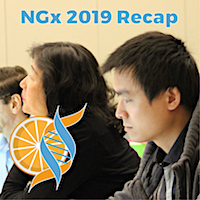Genes and Nutrition
Each of us is metabolically unique. Gene variations known as SNPs (single nucleotide polymorphisms) often are a factor in an individual’s ability to metabolize or use nutrients efficiently. Each of our specific nutrient needs is affected by which specific combination of SNPs we have, but with thousands known to impact nutrition metabolism, how do we know what those needs are?
NRI researchers are working to create a “catalog” of SNPs that alter our nutritional needs by understanding how genetic and other complex biological information can be used to better estimate individual nutrition requirements and intolerances. Our scientists use bioinformatics to extract such information from population and intervention studies, develop rules for predicting individual needs, and bring precision nutrition to health care providers and consumers with digital tools.
Publications
Genes and Nutrition Publications
2020
Genetic variants affecting bone mineral density and bone mineral content at multiple skeletal sites in Hispanic children. Voruganti VS
Precision (Personalized) Nutrition: Understanding Metabolic Heterogeneity. Zeisel S
2019
DNA methylation in mice is influenced by genetics as well as sex and life experience. French J
Cytosolic 10-formyltetrahydrofolate dehydrogenase regulates glycine metabolism in mouse liver. Krupenko S
Deleterious mutations in ALDH1L2 suggest a novel cause for neuro-ichthyotic syndrome. Krupenko S
Fine mapping and identification of serum urate loci in American Indians: The Strong Heart Family Study. Voruganti VS
Heterogeneity in Metabolic Responses to Dietary Fructose. Voruganti VS
Genetic analysis of hsCRP in American Indians: The Strong Heart Family Study. Voruganti VS
A trans-ancestral meta-analysis of genome-wide association studies reveals loci associated with childhood obesity. Voruganti VS
Healthy dietary patterns and risk and survival of breast cancer: a meta-analysis of cohort studies. Voruganti VS
Omega-3 Fatty Acids and Genome-Wide Interaction Analyses Reveal DPP10-Pulmonary Function Association. Voruganti VS
2018
C16-ceramide is a natural regulatory ligand of p53 in cellular stress response. Krupenko N
Nutritional Genomics of Cardiovascular Disease. Voruganti VS
Genetic determinants of BMI from early childhood to adolescence: the Santiago Longitudinal Study. Voruganti VS
Serum Lipid Concentrations and FADS Genetic Variants in Young Mexican College Students: The UP-AMIGOS Cohort Study. Voruganti VS
Arsenic-gene interactions and beta-cell function in the Strong Heart Family Study. Voruganti VS
Dietary Modulation of the Epigenome. Zeisel S
2017
Exome sequencing reveals novel genetic loci influencing obesity-related traits in Hispanic children. Voruganti VS
Genetic variation underlying renal uric acid excretion in Hispanic children: the Viva La Familia Study. Voruganti VS
Reduced brain volume and impaired memory in betaine homocysteine S-methyltransferase knockout mice. Zeisel S
Choline, Other Methyl-Donors and Epigenetics. Zeisel S
2016
CerS6 Is a Novel Transcriptional Target of p53 Protein Activated by Non-genotoxic Stress. Krupenko N
Genotype, B-vitamin status, and androgens affect spaceflight-induced ophthalmic changes. Zeisel S
Related News
A metabolomics approach to investigate kukoamine B – a potent natural product with anti-diabetic properties.
Recap: 2019 Nutrigenetics, Nutrigenomics and Precision Nutrition Short Course
Participants from around the world attended the NRI’s fourth consecutive Nutrigenetics, Nutrigenomics, and Precision Nutrition Short Course from June 3 – 6 in Kannapolis on the North Carolina Research Campus. Known as “NGx,” the 4-day, workshop-style course provides...
Infant Nutrition and Cognition Study
Study Purpose: The purpose of this research study is to determine if eating eggs during breastfeeding will improve nutrient content of milk and infant cognition. Recruiting: Healthy lactating women at 12-15 weeks postpartum What participants will do: You and your...
Infant Nutrition and Cognition Study
Study Purpose:
To show how nutrition helps babies grow and learn.
Recruitment Requirements:
• 18 to 35-year-old women who are pregnant and plan to breastfeed, or breastfeeding babies younger than 3 months
Community Resources
US Post Office Kannapolis Library Kannapolis Parks & Recreation Shopping Oak Avenue Mall – 0.7 miles – within walking distance to NRI 358 Oak Ave Mall Dr, Kannapolis , NC 28081 Contains Grocery (Food Lion), Discount (Family Dollar), and Restaurants (Subway, Pizza...
Housing
Long-term American Homes 4 Rent Atlantic American (Castle & Cooke) Coopers Ridge Apartments Integra Springs Apartments at Kellswater Legacy Grand at Concord Apartments The Ridges Apartments Vida Apartments Inform landlord that you are employed at UNC Chapel Hill...




